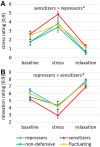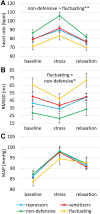Repressive and vigilant coping styles in stress and relaxation: evidence for physiological and subjective differences at baseline, but not for differential stress or relaxation responses
- PMID: 37720657
- PMCID: PMC10502326
- DOI: 10.3389/fpsyg.2023.1196481
Repressive and vigilant coping styles in stress and relaxation: evidence for physiological and subjective differences at baseline, but not for differential stress or relaxation responses
Abstract
Introduction: Previous research suggested differential stress reactivity depending on individuals' coping style, e.g., as classified by the model of coping modes. Specifically, stronger physiological reactivity and weaker subjective stress ratings were found for repressors than for sensitizers. However, it remains to be investigated (i) whether these findings, which are largely based on social stress induction protocols, also generalize to other stressors, (ii) whether repressors vs. sensitizers also exhibit differential stress recovery following the application of a relaxation method, and (iii) which stress reactivity and recovery patterns are seen for the two remaining coping styles, i.e., fluctuating, and non-defensive copers. The current study thus examines stress reactivity in physiology and subjective ratings to a non-social stressor and the subsequent ability to relax for the four coping groups of repressors, sensitizers, fluctuating, and non-defensive copers.
Methods: A total of 96 healthy participants took part in a stress induction (Mannheim Multicomponent Stress Test) and a subsequent relaxation intervention. Subjective ratings of stress and relaxation, heart rate (HR), heart rate variability (HRV), and blood pressure were assessed during the experiment. HR and blood pressure are markers of the sympathetic stress response that can be regulated by relaxation, while HRV should increase with relaxation. To investigate long-term relaxation effects, subjective ratings were also assessed on the evening of testing.
Results: Despite successful stress induction, no differential responses (baseline to stress, stress to relaxation) were observed between the different coping groups on any of the measures. In contrast, a strong baseline effect was observed that persisted throughout the experiment: In general, fluctuating copers showed lower HR and higher HRV than non-defensive copers, whereas repressors reported lower subjective stress levels and higher levels of relaxation during all study phases. No differences in subjective ratings were observed in the evening of testing.
Conclusion: Contrary to previous research, no differential stress reactivity pattern was observed between coping groups, which could be due to the non-social type of stressor employed in this study. The novel finding of physiological baseline differences between fluctuating and non-defensive individuals is of interest and should be further investigated in other stressor types in future research.
Keywords: MMST; blood pressure; heart rate variability; relaxation; repressors; sensitizers; stress.
Copyright © 2023 Exner, Kampa, Finke, Stalder, Klapperich, Hassenzahl, Kleinke and Klucken.
Conflict of interest statement
The authors declare that the research was conducted in the absence of any commercial or financial relationships that could be construed as a potential conflict of interest.
Figures


Similar articles
-
Repressors exhibit lower cortisol reactivity to group psychosocial stress.Psychoneuroendocrinology. 2019 May;103:33-40. doi: 10.1016/j.psyneuen.2018.12.220. Epub 2018 Dec 17. Psychoneuroendocrinology. 2019. PMID: 30639935
-
The effects of social context and defensiveness on the physiological responses of repressive copers.J Pers Soc Psychol. 1997 Nov;73(5):1118-28. doi: 10.1037//0022-3514.73.5.1118. J Pers Soc Psychol. 1997. PMID: 9417480
-
Repressive coping and cardiovascular reactivity to novel and recurrent stress.Anxiety Stress Coping. 2017 Sep;30(5):562-574. doi: 10.1080/10615806.2016.1274027. Epub 2017 Jan 20. Anxiety Stress Coping. 2017. PMID: 28067542
-
Coping style and immunity in animals: making sense of individual variation.Brain Behav Immun. 2008 Jul;22(5):662-7. doi: 10.1016/j.bbi.2007.11.006. Epub 2008 Apr 18. Brain Behav Immun. 2008. PMID: 18395410 Review.
-
Meta-analysis of the effectiveness of the Trier Social Stress Test in eliciting physiological stress responses in children and adolescents.Psychoneuroendocrinology. 2020 Jun;116:104582. doi: 10.1016/j.psyneuen.2020.104582. Epub 2020 Jan 16. Psychoneuroendocrinology. 2020. PMID: 32305745 Review.
References
-
- Derakshan N., Eysenck M. W. (1997). Repression and repressors. Eur. Psychol. 2, 235–246. doi: 10.1027/1016-9040.2.3.235 - DOI
-
- Derakshan N., Eysenck M. W., Myers L. B. (2007). Emotional information processing in repressors: the vigilance–avoidance theory. Cognit. Emot. 21, 1585–1614. doi: 10.1080/02699930701499857 - DOI
LinkOut - more resources
Full Text Sources

